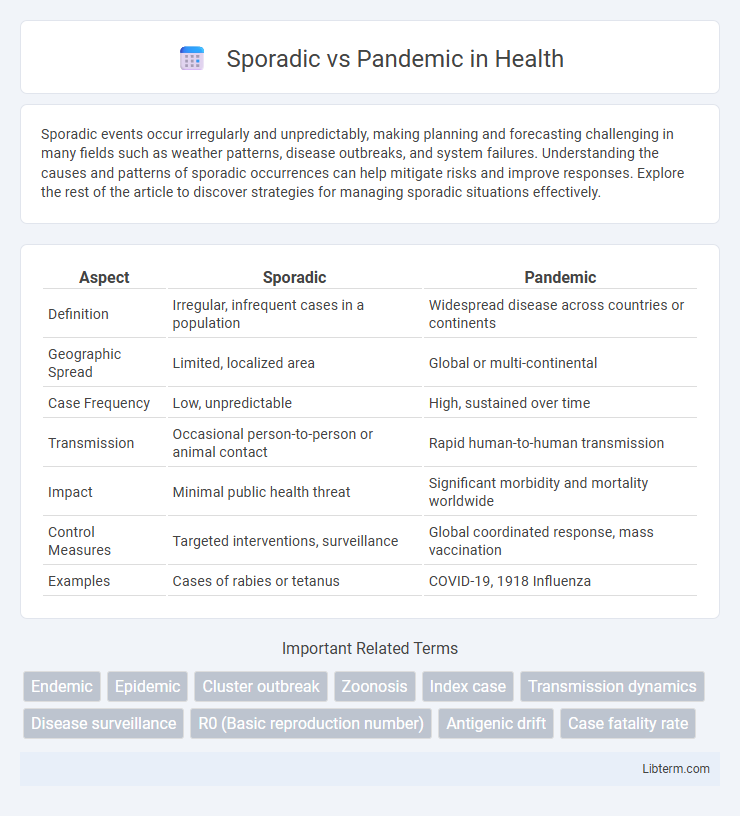Sporadic events occur irregularly and unpredictably, making planning and forecasting challenging in many fields such as weather patterns, disease outbreaks, and system failures. Understanding the causes and patterns of sporadic occurrences can help mitigate risks and improve responses. Explore the rest of the article to discover strategies for managing sporadic situations effectively.
Table of Comparison
| Aspect | Sporadic | Pandemic |
|---|---|---|
| Definition | Irregular, infrequent cases in a population | Widespread disease across countries or continents |
| Geographic Spread | Limited, localized area | Global or multi-continental |
| Case Frequency | Low, unpredictable | High, sustained over time |
| Transmission | Occasional person-to-person or animal contact | Rapid human-to-human transmission |
| Impact | Minimal public health threat | Significant morbidity and mortality worldwide |
| Control Measures | Targeted interventions, surveillance | Global coordinated response, mass vaccination |
| Examples | Cases of rabies or tetanus | COVID-19, 1918 Influenza |
Introduction to Disease Occurrence Patterns
Sporadic disease occurrence refers to isolated, irregular cases appearing unpredictably within a population, often without clear patterns or widespread impact. In contrast, pandemics involve the rapid and extensive spread of infectious diseases across multiple countries or continents, affecting a large portion of the global population. Understanding these patterns is crucial for epidemiological surveillance and implementing effective public health responses.
Defining Sporadic Diseases
Sporadic diseases occur irregularly and infrequently within a population, with cases appearing isolated and without a predictable pattern. These diseases typically arise from local or environmental factors, lacking wide geographic spread or person-to-person transmission. Understanding sporadic diseases involves recognizing their limited occurrence compared to pandemics, which affect large populations across multiple countries or continents simultaneously.
Understanding Pandemics
Pandemics occur when infectious diseases spread over multiple countries or continents, affecting a large portion of the global population, unlike sporadic outbreaks which are isolated and localized. Understanding pandemics involves analyzing factors such as virus transmissibility, mutations, population density, and international travel patterns that facilitate rapid global dissemination. Effective pandemic response relies on early detection, robust healthcare infrastructure, widespread vaccination campaigns, and international collaboration to mitigate the impact on public health.
Key Differences: Sporadic vs Pandemic
Sporadic diseases occur irregularly and infrequently in isolated regions, affecting a small number of individuals without widespread transmission. Pandemics involve the rapid and extensive spread of a disease across multiple countries or continents, impacting a large portion of the global population. Key differences include scale of spread, frequency, and public health response intensity.
Epidemiological Factors Influencing Spread
Sporadic outbreaks occur irregularly with limited cases and minimal human-to-human transmission, often influenced by isolated environmental or animal reservoirs. Pandemic spread results from sustained person-to-person transmission across multiple countries or continents, driven by factors such as high population density, global travel, and pathogen mutations enhancing transmissibility. Epidemiological factors like incubation period, reproductive number (R0), and public health interventions critically shape the transition from sporadic cases to widespread pandemic events.
Examples of Sporadic Diseases
Sporadic diseases occur infrequently and irregularly, often isolated to a few cases without widespread transmission. Examples include Creutzfeldt-Jakob disease, which affects the brain sporadically worldwide, and tetanus, typically resulting from localized wounds contaminated with Clostridium tetani spores. These diseases contrast with pandemics, which involve widespread, continuous transmission across large populations.
Notable Historical Pandemics
Notable historical pandemics such as the Black Death (1347-1351), which caused an estimated 75-200 million deaths, and the 1918 Spanish Flu, with roughly 50 million fatalities globally, highlight the severe and widespread nature of pandemics compared to sporadic outbreaks. Unlike sporadic cases that appear irregularly and locally with limited impact, pandemics involve rapid and extensive transmission across multiple countries or continents, overwhelming public health systems. Understanding the scale and impact of these pandemics informs modern strategies for surveillance, containment, and vaccination efforts.
Impacts on Public Health Systems
Sporadic outbreaks typically exert localized pressure on public health systems, requiring targeted resources and rapid response teams to contain isolated cases. In contrast, pandemics overwhelm healthcare infrastructure globally, causing widespread shortages of medical supplies, hospital beds, and healthcare personnel. Effective pandemic preparedness demands scalable resource allocation, robust surveillance, and international cooperation to mitigate systemic strain.
Prevention and Control Strategies
Sporadic disease cases require targeted surveillance and rapid response to isolate infected individuals and prevent localized outbreaks. Pandemic prevention emphasizes global coordination, widespread vaccination campaigns, and robust public health infrastructure to reduce transmission across countries. Both strategies rely on early detection, effective communication, and implementation of hygiene measures to control spread.
Future Outlook: Preparedness and Response
Future preparedness for sporadic and pandemic outbreaks centers on enhanced surveillance systems, rapid diagnostic technologies, and robust international collaboration frameworks to enable timely detection and containment. Investments in vaccine research, public health infrastructure, and scalable response plans are critical to mitigate the impact of both localized sporadic cases and widespread pandemics. Emphasizing data-driven strategies and adaptive resource allocation strengthens global resilience against emerging infectious threats.
Sporadic Infographic

 libterm.com
libterm.com